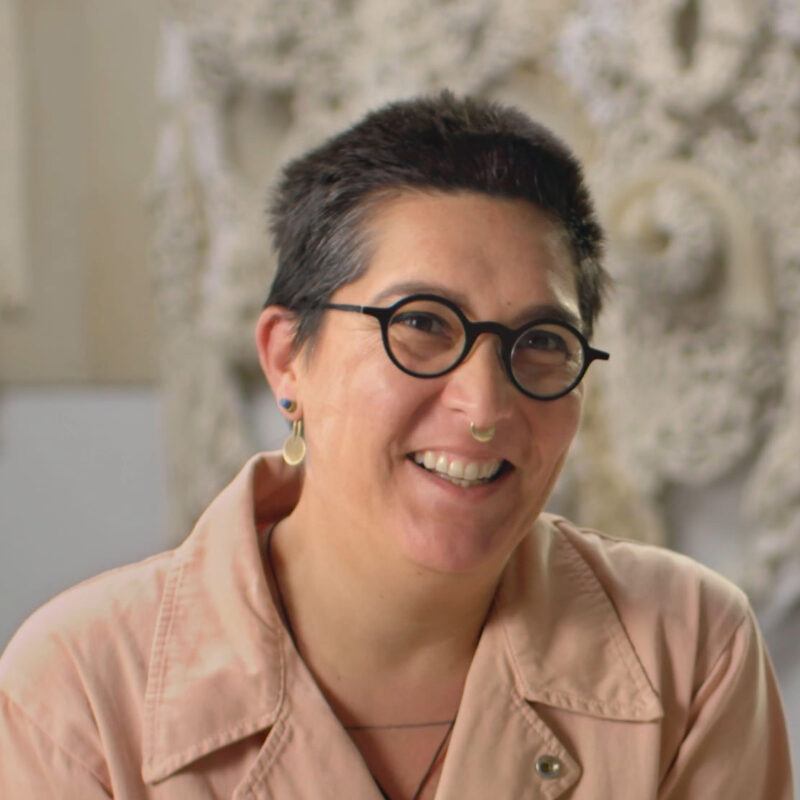Continue playing
(Time remaining: )
Play from beginning
Continue playing "{{ controller.videos[controller.getVideo(controller.currentVideo)].segmentParentTitle}}"
{{controller.videos[controller.getVideo(controller.currentVideo)].title}} has ended.
Crafting LineageTanya Aguiñiga
One of five new films from Art21’s fall 2021 programming
Shown at work in and around her studio in Los Angeles, California, Tanya Aguiñiga revisits the paths that place her work amongst a history of creative traditions, forging her own journey to making work that speaks to a wider audience.
Aguiñiga, who grew up in Tijuana and migrated to San Diego every day for school, studied furniture design in university as a way to pursue her creative interests, while also learning technical skills like woodworking and welding that her parents would appreciate. Through her studies, she developed a respect for legacies in craft and an admiration for traditions that have been passed down through generations. “A lot of us whose parents’ migrated don’t have lineages,” says the artist. Aguiñiga found inspiration through her teacher, Japanese-American furniture designer Wendy Maruyama, whose provocative work around gender and identity taught her how to explore her own struggles with identity through her work.
Today, Aguiñiga blends her craft and art practices, integrating various materials and methods into her sculptures, installations, and performances. Carrying on the tradition of community collaboration and information sharing, she works with a team of artists and craftspeople, while also including her daughter in hands-on artmaking. Aguiñiga often utilizes fabric and fibers in her work, explaining how working with textiles empowers makers with both self-sufficiency and ownership of their identities. The artist travels to the San Ysidro border crossing point in Tijuana, the site of her 2016 Border Quipu project, and reflects on the ways in which she believes art can be of greater service than she previously understood. “Art can offer different ways of getting to an answer, it can offer different possibilities, generative space, power over your own identity,” says Aguiñiga. “For a lot of us that are marginalized or seen as ‘others,’ it can explore different ways of telling our stories.”
Credits
Series Producer: Ian Forster. Director: Ian Forster, Rafael Salazar Moreno, and Ava Wiland. Editor: Janah Elise Cox. Field Producer: Yadira Avila. Camera: Christian Bruno and Rafael Salazar Moreno. Sound: Veronica Lopez and Ariel Baca. Colorist: Jonah Greenstein. Sound Mix: Adam Boese. Music: Blue Dot Sessions. Artwork Courtesy: Tanya Aguiñiga and Wendy Maruyama.
Extended Play is supported by The Andy Warhol Foundation for the Arts; and, in part, by public funds from the New York City Department of Cultural Affairs in partnership with the City Council; Dawn and Chris Fleischner; the Art21 Contemporary Council; and by individual contributors.
Closed captionsAvailable in English, German, Romanian, Italian, Japanese, Korean, Chinese, Italian
Through the Art21 Translation Project, multilingual audiences from around the globe can contribute translations, making Art21 films more accessible worldwide. Translate this video now.
Interested in showing this film in an exhibition or public screening? To license this video please visit Licensing & Reproduction.
Tanya Aguiñiga was born in 1978 in San Diego, California, and raised in Tijuana, Mexico. An artist, designer, and craftsperson, Aguiñiga works with traditional craft materials like natural fibers and collaborates with other artists and activists to create sculptures, installations, performances, and community-based art projects. Drawing on her upbringing as a binational citizen, who daily crossed the border from Tijuana to San Diego for school, Aguiñiga’s work speaks of the artist’s experience of her divided identity and aspires to tell the larger and often invisible stories of the transnational community.
“Art can offer different ways of getting to an answer. For a lot of us that are marginalized, or seen as others, we can explore different ways of telling our stories.”
Tanya Aguiñiga

